 W
WAcropora abrotanoides is a species of acroporid coral found in Indo-Pacific waters from the Red Sea and the Gulf of Aden east to the East China Sea, Japan, the central Pacific Ocean and Australia. It is found in shallow coral reefs that are exposed to the action of strong waves, at depths up to 15 m. It is vulnerable to coral bleaching, disease and crown-of-thorns starfish. It is resistant to predation as it has well-developed radial corallite lips.
 W
WAcropora aculeus is a species of acroporid corals found throughout the Indian Ocean, the central Indo-Pacific, Australia, southeast Asia, Japan and the East China Sea. It is also present in the western Pacific Ocean. It is an uncommon species and is particularly prone to coral bleaching, disease, and crown-of-thorns starfish predation; it is also harvested for use in aquaria, and the International Union for Conservation of Nature has assessed it as being a "vulnerable species". Habitat loss is a big concern.
 W
WAcropora cerealis is a species of acroporid coral found throughout the Indian and Pacific oceans, from the Red Sea and the Gulf of Aden to the Hawaiian Islands and the Johnston Atoll. It can be found on upper reef slopes in shallow tropical reefs, from depths of 3–20 m. Crown-of-thorns starfish preferentially prey upon Acropora corals, and this species is also harvested for the aquarium trade.
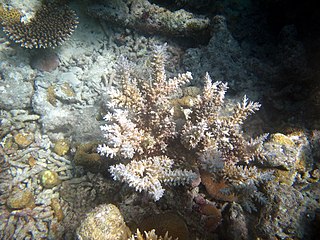 W
WAcropora echinata is a species of acroporid coral that was first described by Dana in 1846. Found in shallow, tropical, sheltered reefs in marine environments, it is found at depths of 8 to 25 m in clear water. The species is listed as vulnerable on the IUCN Red List, and has a decreasing population. It is not common but found over a large area, and is listed under CITES Appendix II.
 W
WAcropora globiceps is a species of acroporid coral found in the oceanic central and western Pacific Ocean and central Indo-Pacific. It can also be found in the Great Barrier Reef, the Philippines, the Andaman Islands, Polynesia, Micronesia and the Pitcairn Islands. It occurs on the slopes of reefs, the flats of reefs, in tropical shallow reefs, and at depths of around 8 metres (26 ft). It was described by Dana in 1846.
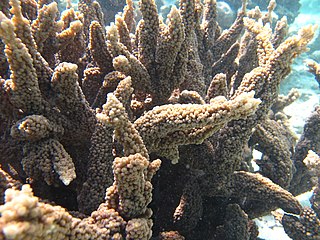 W
WAcropora hemprichii is a species of acroporid coral that was first described by Christian Gottfried Ehrenberg in 1834. Found in shallow reefs in marine environments, this species occurs at depths of 3 to 15 m, and lives for between 13 and 24 years. The species is listed as vulnerable on the IUCN Red List, and has a decreasing population. It is common with a wide range, and is listed on Appendix II of CITES.
 W
WAcropora horrida is a species of acroporid coral that was first described by James Dwight Dana in 1846. Found in tropical, shallow reefs in marine environments, it occurs near fringing reefs around turbid water, at depths of 5 to 20 m. It is listed as a vulnerable species on the IUCN Red List, and it is thought to have a decreasing population. It is not common and found over a large area, and is listed under CITES Appendix II.
 W
WAcropora lutkeni is a species of acroporid coral found in the central Indo-Pacific, Japan, Australia, the northern Indian Ocean, the East China Sea, southeast Asia, and the central and western Pacific Ocean. The species also occurs in the south Mariana Islands, American Samoa, Palau, the Andaman Islands, Fiji, the Philippines, the Banggai Islands, Samoa, the Raja Ampat Islands, the Line Islands, Papua New Guinea, and the Chagos Archipelago. It exists in tropical shallow reefs on upper slopes that are exposed to the action of strong waves or currents, and subtidally on edges of reefs and in submerged reefs. It exists at depths of between 3 and 12 metres and probably spawns in October.
 W
WAcropora microclados is a species of acroporid coral that was first described by Christian Gottfried Ehrenberg in 1834. Found in marine, tropical shallow reefs on the upper slopes, it is found at depths of 5 to 20 m. It is listed as a vulnerable species on the IUCN Red List, and its population is decreasing. It is uncommon but found over a large area, including in five regions of Indonesia, and is classified under CITES Appendix II.
 W
WAcropora muricata, commonly called staghorn coral, is a species of acroporid coral found in the Gulf of Aden, the Red Sea, Indian Ocean, Persian Gulf, Australia, central Indo-Pacific, Japan, Southeast Asia, the East China Sea and the oceanic central and western Pacific Ocean. It is found in tropical shallow reefs, slopes of reefs, and in lagoons, from depths of 5 to 30 m. It was described by Dana in 1846.
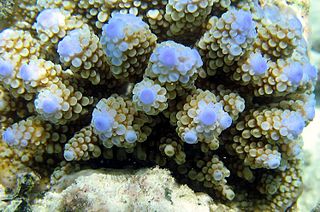 W
WAcropora nasuta is a species of branching stony coral in the family Acroporidae. It is native to the western and central Indo-Pacific where it is found in shallow reef habitats. Like other corals of the genus Acropora, it is susceptible to coral bleaching and coral diseases and the IUCN has listed it as being "Near Threatened".
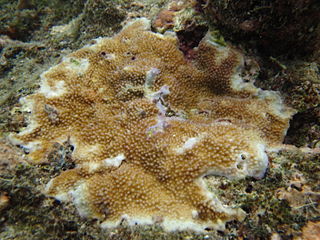 W
WAcropora palmerae is a species of acroporid coral found in the northern Indian Ocean, the central Indo-Pacific, Australia, Southeast Asia, Japan, the East China Sea and the oceanic west Pacific Ocean. It is also found in Palau and the Mariana Islands, American Samoa, the Andaman Islands, the Great Barrier Reef, Okinawa Island, Mauritius, Micronesia, the Cook Islands and the Philippines. It occurs in tropical shallow reefs on flats exposed the action of strong waves and in lagoons, from depths of 0 to 12 metres. It was described by Wells in 1954.
 W
WAcropora samoensis is a species of acroporid coral found in the Red Sea, the Gulf of Aden, the southwest and northern Indian Ocean, the central Indo-Pacific, Australia, Southeast Asia, Japan, the East China Sea and the oceanic west and central Pacific Ocean. It occurs in tropical shallow reefs on upper slopes of reefs, from depths of 5 to 15 metres. It was described by Brook in 1891.
 W
WAcropora valida is a species of acroporid coral found in the Red Sea, the Gulf of Aden, the southwestern, northwestern and northern Indian Ocean, the Persian Gulf, the central Indo-Pacific, Australia, southeast Asia, Japan, the East China Sea, the oceanic western, central and far eastern Pacific Ocean, the northwestern Hawaiian Islands and Johnston Atoll. It occurs in tropical shallow reefs in a variety of reef habitats, at depths of 1 to 15 metres.
 W
WAcropora vaughani is a species of acroporid coral found in the northern Indian Ocean, the central Indo-Pacific, Australia, southeast Asia, Japan, the East China Sea and the oceanic western and central Pacific Ocean. It is also found in Madagascar. It occurs in tropical shallow reefs around fringing reefs in turbid water, at depths of between 3 and 20 metres. It was described by J. W. Wells in 1954.
 W
WAcropora verweyi is a species of acroporid coral found in the southwest and northern Indian Ocean, the central Indo-Pacific, Australia, southeast Asia, Japan, the East China Sea and the oceanic western Pacific Ocean. It is also found in the Philippines, American Samoa, Fiji and Rodrigues. It occurs in tropical shallow reefs on upper slopes, from depths of 2 to 15 metres.
 W
WAglaophenia pluma, the toothed feather hydroid or podded hydroid, is a colonial hydroid in the family Aglaopheniidae and is found worldwide. It lives from the shore to 120m under water.
 W
WAnacropora is a genus of stony corals in the Acroporidae family. They are sometimes called briar corals and there are seven known species.
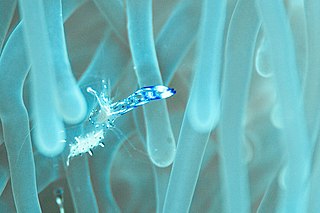 W
WAncylomenes holthuisi is a species of marine shrimp in the family Palaemonidae. It is widespread throughout the tropical waters of the Indo-West Pacific. It is a cleaner shrimp and usually lives in association with sea anemones, scleractinian corals or jellyfish.
 W
WAphanipathes is a diverse genus of black corals in the family Aphanipathidae, typified by large polypar spines. However, there are some disagreement in the correct taxonomic classification of this genus. The Global Biodiversity Information Facility (GBIF) classifies Aphanipathes as being a genus of the family Aphanipathidae while the Integrated Taxonomic Information System (ITIS) classifies it as a genus of the family Antipathidae.
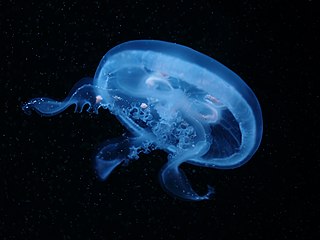 W
WAurelia labiata is a species of moon jellyfish. It is a cnidarian in the family Ulmaridae. It is typically larger than Aurelia aurita, with individuals document up to 45cm. However much of its size range overlaps with A. aurita, making size an imperfect diagnostic tool. Most Aurelia labiata have a 16-scalloped bell, meaning the bell indents inward at 16 points.
 W
WAntipatharians, also known as black corals or thorn corals, are an order of soft deep-water corals. These corals can be recognized by their jet-black or dark brown chitin skeletons, surrounded by the polyps. Antipatharians are a cosmopolitan order, existing at nearly every location and depth, with the sole exception of brackish waters. However, they are most frequently found on continental slopes under 50 m (164 ft) deep. A black coral reproduces both sexually and asexually throughout its lifetime. Many black corals provide housing, shelter, food, and protection for other animals.
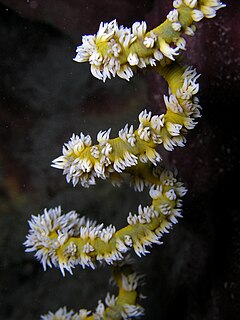 W
WCirrhipathes is a genus of black coral from the family Antipathidae. Coral species in this genus are commonly known as whip or wire corals because they often exhibit a twisted or coiled morphology. In addition to their colorful appearance, with colors ranging from yellow to red passing through blue and green, these species possess a dark skeleton that is characteristic to every black coral.
 W
WCtenactis is a genus of solitary disc corals in the family Fungiidae. Members of this genus are found in the Indo-Pacific region.
 W
WCtenactis echinata is a free-living species of solitary disc coral in the family Fungiidae. It is native to the Indo-Pacific region. This is a common species throughout its wide range and the International Union for Conservation of Nature has rated its conservation status as being of "least concern".
 W
WCycloseris is a genus of solitary disc corals in the family Fungiidae. They are found in the Indo-Pacific. They inhabit the lower reef slopes, and the areas between reefs with soft sediments. They tolerate turbid waters.
 W
WDanafungia scruposa is a species of coral that is the first to have been observed to eat jellyfish. It was described by Klunzinger in 1879 and has a diameter of around 25 centimetres (9.8 in). It is rated as a least-concern species.
 W
WThe Indo-Pacific bottlenose dolphin is a species of bottlenose dolphin. This dolphin grows to 2.6 m (8.5 ft) long, and weighs up to 230 kg (510 lb). It lives in the waters around India, northern Australia, South China, the Red Sea, and the eastern coast of Africa. Its back is dark grey and its belly is lighter grey or nearly white with grey spots.
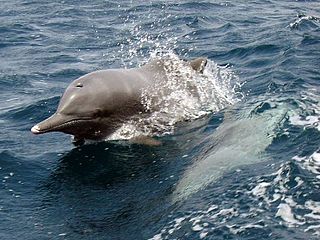 W
WThe Indian Ocean humpback dolphin is a member of the Delphinidae family occupying coastal areas ranging from Southern Africa to Western Indochina. The Indo-Pacific humpback dolphin was formerly included within the same species, but a 2014 study revealed them to be a separate species.
 W
WThe dragon poacher is a fish in the family Agonidae (poachers). It was described by Peter Simon Pallas in 1769, originally under the genus Cottus. It is a marine, deep water-dwelling fish which is known from the northern Pacific Ocean, including the Sea of Japan, the Sea of Okhotsk, and the Bering Sea. It dwells at a depth range of 19 to 750 metres, and inhabits gravel, sand and mud sediments. Males can reach a maximum total length of 42 centimetres (17 in).
 W
WHeliofungia actiniformis is a solitary species of mushroom coral, a large polyp stony coral in the family Fungiidae. This coral is found in shallow water in the Indo-Pacific region. It is a zooxanthellate species. It is a popular coral in the reef aquarium trade; wild populations are threatened by disease, climate change, and over-collecting, and the species is considered vulnerable by the IUCN.
 W
WGoniobranchus hintuanensis is a species of colorful sea slug, a dorid nudibranch, a marine gastropod mollusk in the family Chromodorididae.
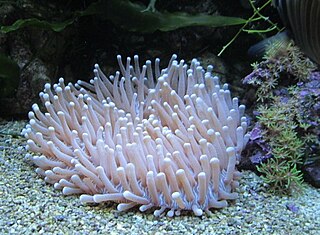 W
WHeliofungia is a genus of stony corals in the family Fungiidae. These corals are found in shallow water in the Indo-Pacific region. They are zooxanthellate corals and were formerly considered to be a subgenus of the genus Fungia.
 W
WHeliofungia actiniformis is a solitary species of mushroom coral, a large polyp stony coral in the family Fungiidae. This coral is found in shallow water in the Indo-Pacific region. It is a zooxanthellate species. It is a popular coral in the reef aquarium trade; wild populations are threatened by disease, climate change, and over-collecting, and the species is considered vulnerable by the IUCN.
 W
WHerpolitha is a monotypic genus of mushroom corals in the family Fungiidae. The only member of the genus is Herpolitha limax, commonly known as the tongue, slipper, mole or striate boomerang coral. It is a free-living species and is native to reefs and lagoons in the Indo-Pacific region. The International Union for Conservation of Nature has assessed this coral as being of "least concern".
 W
WHerpolitha is a monotypic genus of mushroom corals in the family Fungiidae. The only member of the genus is Herpolitha limax, commonly known as the tongue, slipper, mole or striate boomerang coral. It is a free-living species and is native to reefs and lagoons in the Indo-Pacific region. The International Union for Conservation of Nature has assessed this coral as being of "least concern".
 W
WHumpback dolphins are members of the genus Sousa. These dolphins are characterized by the conspicuous humps and elongated dorsal fins found on the backs of adults of the species. They are found close to shore along the coast of West Africa and right along the coast of the Indian Ocean from South Africa to Australia. Several institutions have made a proposal to divide the Indo-Pacific species into two distinct species: the Indo-Pacific humpback dolphin and the Australian humpback dolphin.
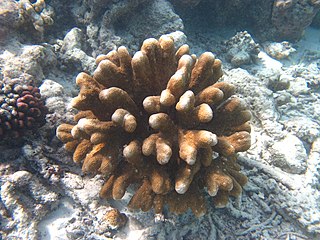 W
WIsopora palifera is a species of stony coral in the family Acroporidae. It is a reef building coral living in shallow water and adopts different forms depending on the water conditions where it is situated. It is found in the Western Indo-Pacific Ocean as far east as Australia.
 W
WLeaf plate montipora, also known as vase coral, cap coral, or plating montipora, is a type of small polyp stony (SPS) coral in the family Acroporidae.
 W
WLithophyllon repanda is a species of mushroom or disc coral in the family Fungiidae.This species is able to move to another location on occasion. The International Union for the Conservation of Nature (IUCN) rated it as a least-concern species and it was originally described by Dana in 1846. It occurs at depths of 1 to 30 metres.
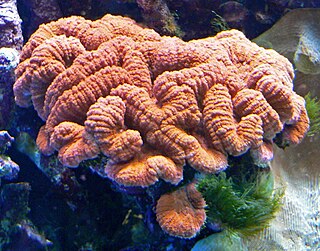 W
WLobophyllia hemprichii, commonly called lobed brain coral, lobed cactus coral or largebrain root coral, is a species of large polyp stony coral in the family Lobophylliidae. It is found in the Indo-Pacific Ocean. In its specific name Christian Gottfried Ehrenberg honoured his late partner the Prussian naturalist Wilhelm Hemprich; they were among the first to study the marine life of the Red Sea.
 W
WMacrorhynchia filamentosa, the smoky feather hydroid, is a colonial hydroid in the family Aglaopheniidae.
 W
WMontipora aequituberculata is a species of stony coral in the family Acroporidae. It is a common coral in shallow water in the Indo-Pacific region.
 W
WMontipora digitata, also known as finger coral, is a species of stony coral. It is found in shallow water in East Africa, the Indo-West Pacific, Kenya, Mozambique and Rodriguez.
 W
WMontipora grisea is a small polyped stony coral in the family Acroporidae.
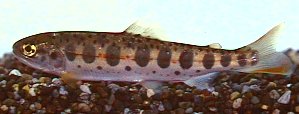 W
WOncorhynchus masou, known as the masu salmon, masu, or the cherry hybrid salmon, is a species of salmon found in the northern part of the Pacific Ocean along East Asia, ranging from the Kamchatka, Kuril Islands, Sakhalin, and Primorsky Krai south through Korea, Taiwan, and Japan. A number of subspecies are known, including the anadromous, widespread masu Oncorhynchus masou masou, the critically endangered, landlocked Taiwanese or Formosan salmon Oncorhynchus masou formosanus found in certain freshwater systems of Taiwan, the Biwa trout endemic of Lake Biwa, and the anadromous or stream-dwelling amago Oncorhynchus masou macrostomus restricted to western Japan.
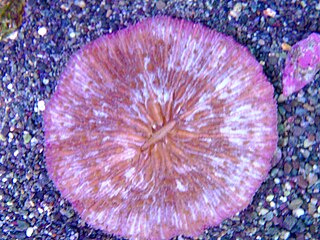 W
WPleuractis paumotensis, commonly called plate coral, is a species of stony coral with a single large polyp. Plate coral are commonly kept in marine aquaria.
 W
WPlumapathes pennacea is a species of black coral in the order Antipatharia. It is found in the tropical Indian, Pacific and Atlantic Oceans in deep reef habitats where it forms part of a biologically diverse community.
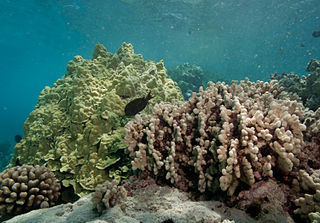 W
WPorites compressa, also known as finger coral or hump coral, is a species of marine stony coral in the family Poritidae. It is found growing on coral reefs and in shallow lagoons in tropical parts of the Indian and Pacific Oceans.
 W
WPorites nodifera, also known as dome coral, is a species of stony coral in the Poritidae family.
 W
WThe sebae anemone, also known as leathery sea anemone, long tentacle anemone, or purple tip anemone, is a species of sea anemone belonging to the family Stichodactylidae and native to the Indo-Pacific area.
 W
WStenopus hispidus is a shrimp-like decapod crustacean belonging to the infraorder Stenopodidea. Common names include banded coral shrimp and banded cleaner shrimp.
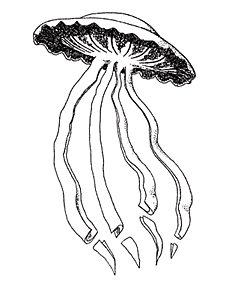 W
WStygiomedusa is a genus of giant deep sea jellyfish in the family Ulmaridae. It is monotypic with a single species, Stygiomedusa gigantea. With only 115 sightings in the last 110 years, it is a jellyfish that is rarely seen, but believed to be widespread throughout the world. It is thought to be one of the largest invertebrate predators in the deep sea ecosystem.
 W
WThor amboinensis, commonly known as the squat shrimp or sexy shrimp, is a species of shrimp found across the Indo-West Pacific and in parts of the Atlantic Ocean. It lives symbiotically on corals, sea anemones and other marine invertebrates in shallow reef communities.
 W
WTiburonia is a genus of jellyfish in the family Ulmaridae. It was reported in 2003, following the discovery of its only species yet identified, Tiburonia granrojo. It was discovered by a crew from MBARI led by George Matsumoto. Pieces of the medusae were collected for morphological analysis, which eventually led to sequencing and taxonomic identification. The discovery of this organism led to not only a new species, but a new subfamily of Ulmaridae, called Tiburoniinae. Its genus was named Tiburonia after the ROV the crew were using, called Tiburon, meaning "shark" in Spanish. Because of this ROVs distinct maneuverability, all angles of the organisms were able to be observed, which is particularly important to the study of gelatinous pelagic invertebrates. Its species name was originally to be called "big ugly", but Kirsten Matsumoto raised objections to this name, and renamed it granrojo, meaning "big red" in Spanish.
 W
WThe pygmy sperm whale is one of two extant species in the family Kogiidae in the sperm whale superfamily. They are not often sighted at sea, and most of what is known about them comes from the examination of stranded specimens.